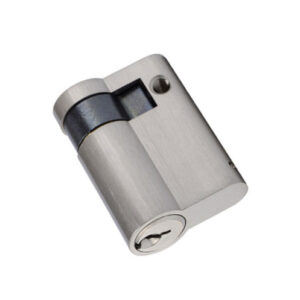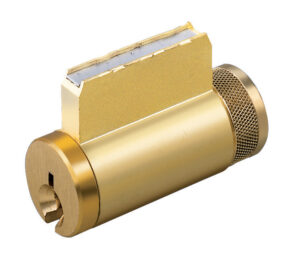Grasping common sizes is vital, particularly in the context of Euro cylinder locks. These locks, prevalent throughout Europe, come in a variety of sizes, each tailored to fit a specific door thickness. The most common Euro cylinder size typically falls between 60mm and 120mm, with 60mm being the standard. This knowledge isn’t just beneficial for homeowners but is also invaluable for security industry professionals. In this article, you can learn details what is the most common euro cylinder size.

Clarification of Euro Cylinder Locks
Euro Cylinder locks, regularly utilized in Europe, are a sort of pin tumbler lock where the chamber can be effectively supplanted without changing the bolt work equipment. This element settles on them a well-known decision for their benefit and flexibility. They are frequently utilized in uPVC entryways and come in different sizes to suit different entryway thicknesses.
Significance of Knowing Normal Sizes
Knowing the normal sizes of Euro Cylinder locks is critical for both security and usefulness. An erroneously estimated lock can think twice about the security of your property and may not work accurately. The most widely recognized sizes are 30/30 (60mm) and 30/40 (70mm), however different sizes are accessible to fit different entryway types. By understanding these sizes, you can guarantee that your lock gives the most extreme degree of safety and works without a hitch
What is the most common euro cylinder size
A. Standardized Sizes
The universe of locks and security frameworks is huge, yet one consistent remaining part: the normalized sizes of Euro Cylinder locks. These locks, regularly utilized in Europe, have a widespread size that fits most entryways. The standard size for a Euro Cylinder lock is 60mm, with 30mm on each side of the chamber. This normalization guarantees that the locks are exchangeable, giving adaptability and comfort to clients.
B. Common Measurements
While the standard size is 60mm, Euro Cylinder secures come in different sizes to oblige different entryway thicknesses. Normal estimations range from 40mm to 100mm. The not set in stone by estimating the separation from the focal point of the screw opening to the edge of the lock on the two sides. For example, a 40/50 Euro Cylinder lock implies that one side is 40mm, and the opposite side is 50mm. These varieties take special care of the different requirements of clients, guaranteeing ideal security paying little heed to entryway size.
C. Factors Influencing Size Variations
A few variables impact the size varieties of Euro Cylinder locks. First and foremost, entryway thickness plays a huge part. Thicker entryways require longer chambers. Besides, the kind of entryway material can likewise influence the size. For example, metal entryways could require different chamber sizes contrasted with wooden entryways. Ultimately, the degree of safety wanted can impact the size. High-security locks frequently have bigger chambers, giving more pins and subsequently, expanded security.
Determining the Most Common Size
A. Research Findings
In the domain of Euro Cylinder locks, deciding the most well-known size is an undertaking that requires broad examination. Studies show that the 60mm Euro Cylinder lock, with 30mm on each side of the chamber, is the most normally utilized. This finding depends on information gathered from different sources, including locksmith administrations, home improvement shops, and online commercial centers. The prominence of the 60mm size can be credited to its adaptability, fitting most standard entryways easily.
B. Industry Standards
Industry principles likewise play a critical part in deciding the most well-known size. The 60mm Euro Cylinder lock lines up with the business’ standard entryway thickness, making it a favored decision for both private and business properties. Makers frequently produce secures in this size because of its popularity, further setting its situation as the most widely recognized size. Nonetheless, it means quite a bit to take note of that while 60mm is the norm, different sizes are likewise accessible to take care of various entryway thicknesses.
C. Regional Preferences
Strangely, territorial inclinations can impact the normal size of Euro Cylinder locks. For example, in locales with more established structures, you could observe that more modest or bigger locks are more pervasive because of the changing entryway thicknesses. Alternately, in fresher turns of events, the 60mm size may be more normal because of current entryway plan principles. Hence, understanding provincial inclinations can give significant bits of knowledge into the most widely recognized secure size in a particular region.

Factors Influencing Cylinder Size Popularity
A. Building Types
The sort of building assumes a critical part in the prominence of specific chamber sizes. For example, private structures frequently favor the 60mm Euro Cylinder lock because of its similarity with standard entryway thicknesses. Then again, business structures could choose bigger sizes to oblige heavier entryways. Authentic structures, with their novel compositional highlights, may require uniquely measured chambers. Hence, the variety in building types adds to the assortment in chamber size fame.
B. Lock Installation Trends
Patterns in lock establishment additionally impact the notoriety of chamber sizes. The simplicity of establishment and upkeep of the 60mm Euro Cylinder lock has made it number one among locksmiths and Do-It-Yourself lovers. Besides, the ascent of savvy locks has prompted an expansion sought after for viable chamber sizes. As innovation progresses, we can anticipate that these patterns should keep advancing, forming the prevalence of various chamber sizes.
C. Security Considerations
Security contemplations are fundamental while picking a chamber size. While more modest chambers may be simpler to introduce, they may not give a similar degree of safety as their bigger partners. Bigger chambers frequently offer more pin mixes, making them harder to pick. Furthermore, the material of the chamber, for example, metal or nickel silver, can influence its protection from lock picking and subsequently its notoriety.
Last Words
To wrap up, the significance of understanding common sizes, especially in the case of Euro cylinder locks, is paramount. It guides you in selecting the right lock for your security needs. The most common Euro cylinder size is 60mm, but it can vary based on your door’s thickness. So, whether you’re a homeowner aiming to boost your property’s security or a professional in the field, this knowledge is essential.
